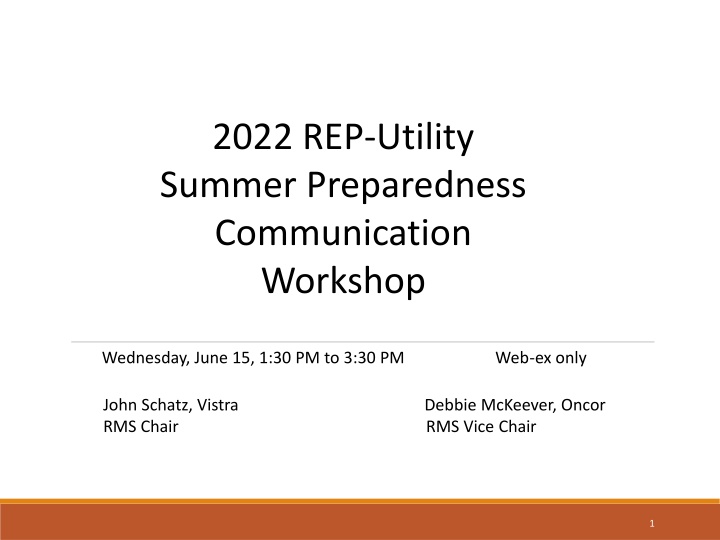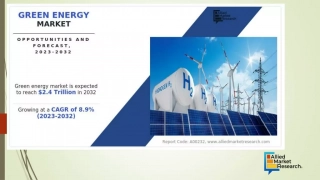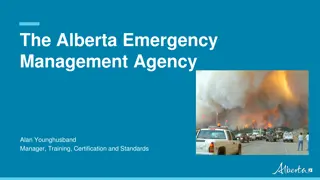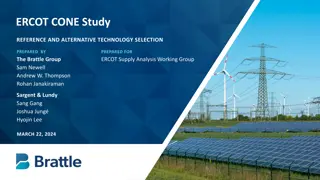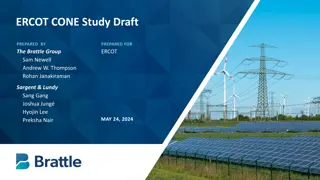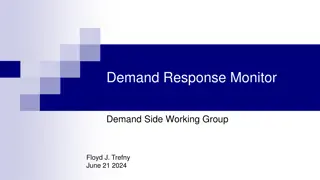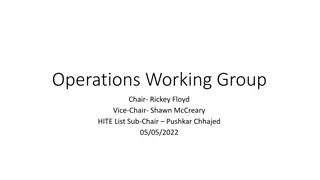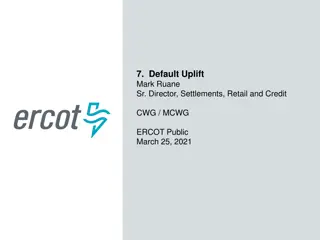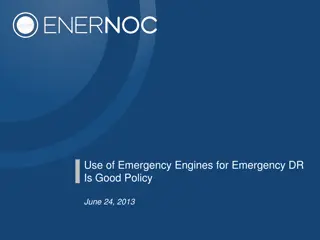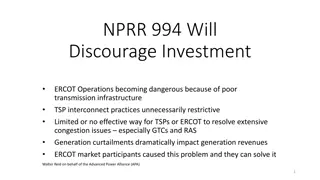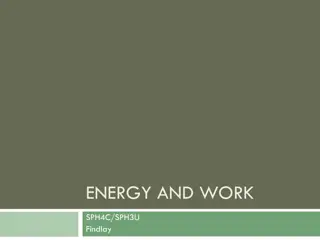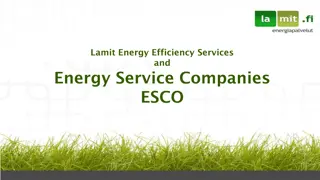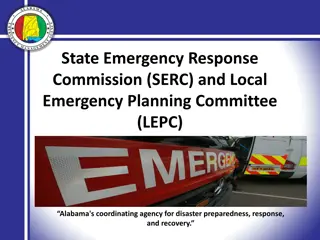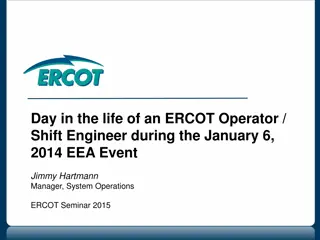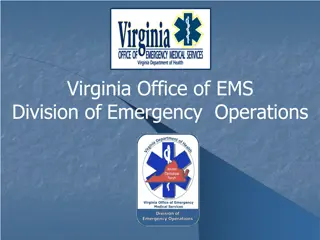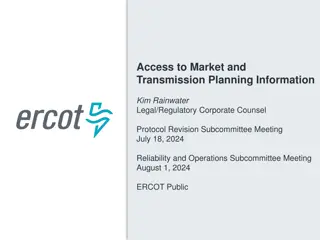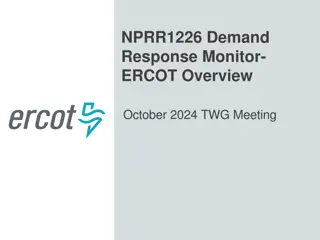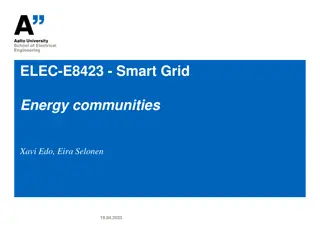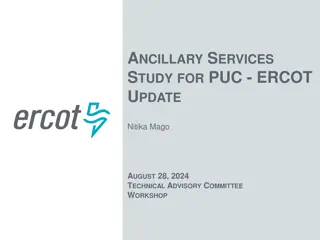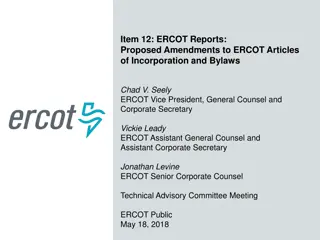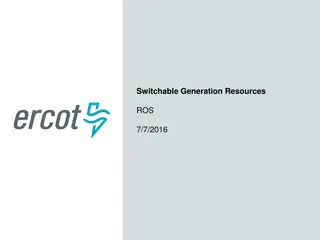ERCOT Energy Emergency Operations Overview
This workshop provides insights into ERCOT's Energy Emergency Alerts (EEAs) and operations plan to maintain electric grid reliability during major weather events. Learn about emergency procedures, resource deployments, and key roles in the ERCOT Retail market. Discover the tools available to prevent system-wide outages and ensure grid integrity. Stay informed about Mass Transition Processes and helpful web resources for preparedness.
Download Presentation

Please find below an Image/Link to download the presentation.
The content on the website is provided AS IS for your information and personal use only. It may not be sold, licensed, or shared on other websites without obtaining consent from the author.If you encounter any issues during the download, it is possible that the publisher has removed the file from their server.
You are allowed to download the files provided on this website for personal or commercial use, subject to the condition that they are used lawfully. All files are the property of their respective owners.
The content on the website is provided AS IS for your information and personal use only. It may not be sold, licensed, or shared on other websites without obtaining consent from the author.
E N D
Presentation Transcript
2022 REP-Utility Summer Preparedness Communication Workshop Wednesday, June 15, 1:30 PM to 3:30 PM Web-ex only John Schatz, Vistra Debbie McKeever, Oncor RMS Chair RMS Vice Chair 1
Agenda Scope and Purpose of workshop ERCOT Energy Emergency Alerts (EEA) ERCOT Role and Responsibilities TSP/TDU Role and Responsibilities ERCOT EEA Procedures Matrix Overview of Mass Transition Processes Helpful Web-site links containing related information Questions and Answers Adjourn 2
Scope and Purpose During some major weather events, it is necessary for ERCOT to deploy emergency operation plans in order to preserve and protect the integrity and reliability of the ERCOT electric grid. This REP/Utility Summer Prep Communication Workshop is being held to provide attendees an overview of processes and procedures established for the ERCOT Retail market which may be executed in the event of a major weather event. Additionally this workshop will include an overview of Mass Transition Processes as currently included in ERCOT Market Rules. A REP/Utility Winter Prep Communication Workshop will be held in Fall of 2022. 3
ERCOT Energy Emergency Alert (EEA) Operations 4
ERCOT EEA Operations ERCOT EEA Operations When electric supply and demand can t be balanced with normal procedures, ERCOT begins emergency operations using three levels of Energy Emergency Alerts (EEAs). Each level provides access to resources that can only be deployed when an energy emergency is declared. These tools are in place to protect the reliability of the electric system and prevent an uncontrolled system-wide outage. ERCOT currently has about 2,300 MW of additional capacity available to address tight grid conditions and can also issue a conservation request to help reduce demand at any time. One megawatt (MW) is enough to power about 200 Texas homes during peak demand. As part of the ERCOT system improvements made over the past six months to enhance grid reliability, the Public Utility Commission has approved policy changes that allow ERCOT to deploy some of the 2,300 MW of resources prior to declaring an energy emergency. The decision to deploy these resources sooner is based on real time grid conditions. 5
Resource Deployments Prior to an Energy Emergency ERCOT continually monitors Grid conditions 24x7. If operating reserves drop below 3,000 MW and are not expected to recover within 30 minutes: Bring all available generation online and release any unused reserves Deploy Emergency Response Service (commercial/small industrial customers who are contractually paid to reduce their power within either 10 or 30 minutes): 1,020 MW Voltage reduction by transmission companies if controlled outages are NOT expected: 100-200 MW 6
ERCOT Energy Emergency Alerts (EEA) Matrix 7
EEA Levels and Actions Level 1 If operating reserves drop below 2,300 MW and are not expected to recover within 30 minutes: Increase other generation supplies and use demand response to lower electric demand, including: Imports from neighboring electric grids, if available: up to 1,220 MW Switchable generation that can serve multiple electric grids, if available: up to 568 MW Remaining Emergency Response Service if applicable (commercial/small industrial customers who are paid to reduce their power during emergencies): 1,020 MW 9
EEA Levels and Actions Level 2 If operating reserves drop below 1,750 MW and are not expected to recover within 30 minutes: Request energy conservation from public (if not already in effect): MW vary Reduce power by deploying remaining demand response programs, including: Deploy operating reserves carried by Load Resources (large industrial customers who are paid to reduce their power): 1,691 MW Load management programs from transmission companies: 211 MW for winter season Voltage reduction by transmission companies if not already deployed: 100-200 MW 10
EEA Levels and Actions Level 3 If operating reserves drop below 1,375 MW, ERCOT moves into level 3. If operating reserves drop below 1,000 MW and are not expected to recover within 30 minutes and/or the grid s frequency level cannot be maintained at 60 Hz: As a last resort, ERCOT will instruct transmission companies to reduce demand on the electric system. These are controlled outages. Note: Some steps may occur simultaneously and do not include additional voluntary demand response programs, where electric service from other ERCOT business and residential customers is interrupted during emergencies. 11
ERCOT Load Shed Table Posting date April, 21, 2022 2021 Total Transmission Operator Load (% MW) Transmission Operator 8.41 AEP Texas Central Company 4.85 Brazos Electric Power Cooperative Inc. 0.37 Brownsville Public Utilities Board 0.52 Bryan Texas Utilities 25.89 CenterPoint Energy Houston Electric LLC 3.54 City of Austin DBA Austin Energy 0.28 City of College Station 0.73 City of Garland 0.58 City of Lubbock 6.44 CPS Energy (San Antonio) 0.48 Denton Municipal Electric 0.14 GEUS (Greenville) 0.36 Golden Spread Electric Cooperative Inc. 0.07 Lamar County Electric Cooperative Inc* 5.89 LCRA Transmission Services Corporation 35.47 Oncor Electric Delivery Company LLC 1.34 Rayburn Country Electric Cooperative Inc. DBA Rayburn Electric 1.92 South Texas Electric Cooperative Inc. 2.72 100.00 Texas-New Mexico Power Company ERCOT Total * Lamar County Electric Cooperative is a registered TO not on the ERCOT Hotline, City of Garland receives all their calls. 13
ERCOT Nodal Protocol 6.5.9.3.4 Emergency Notice (1) Emergency Notice is the communication issued by ERCOT when operating in an Emergency Condition. (2) ERCOT shall issue an Emergency Notice for one or both of the following reasons: (a) ERCOT cannot maintain minimum reliability standards (for reasons including fuel shortages) during the Operating Period using every Resource practicably obtainable from the market; or (b) Immediate action cannot be taken to avoid or relieve a Transmission Element operating above its Emergency Rating. (3) The actions ERCOT takes during an Emergency Condition depend on the nature and severity of the situation. (4) ERCOT is considered to be in an Emergency Condition whenever ERCOT Transmission Grid status is such that a violation of security criteria, as defined in the Operating Guides, presents the threat of uncontrolled separation or cascading Outages and/or large-scale service disruption to Load (other than Load being served from a radial transmission line) and/or overload of a Transmission Element, and no timely solution is obtainable through SCED or CMPs. (5) If the Emergency Condition is the result of a transmission problem, ERCOT shall act immediately to return the ERCOT System to a reliable condition, including instructing Resources to change output, curtailing any remaining DC Tie Load, and instructing TSPs or DSPs to drop Load. 14
TSP/DSP Role & Responsibilities 15
Once the TSP/DSP receives Energy Emergency Alert (EEA) Load Shedding Once the TSP/DSP receives Energy Emergency Alert (EEA) Load Shedding instructions from ERCOT, the TSP/DSP s responsibility is to perform all instructions from ERCOT, the TSP/DSP s responsibility is to perform all necessary actions as prescribed in the necessary actions as prescribed in the ERCOT Nodal Operating Guide. ERCOT Nodal Operating Guide. Nodal Operating Guide 4.5.3.4 Load Shed Obligation (1) ERCOT Load shed instructions are effectuated. Each DSP shall comply with any reasonable instruction given by its TO to effectuate Load shed obligations. Each Transmission Operator (TO) shall take and direct actions to ensure that (2) TSP peak Loads, as reported to ERCOT, and will be reviewed by ERCOT and revised annually or as otherwise appropriate to reflect any new or changed TO designation. ERCOT shall maintain a Load Shed Table posted on the ERCOT website that reflects each TO s total Load shed obligation. Percentages for Level 3 Load shedding will be based on the previous year s (3) or changed TO designation, ERCOT shall post any anticipated revisions to the Load Shed Table on the ERCOT website. ERCOT shall issue a Market Notice announcing the posting of the revisions at least ten days prior to the effective date of the revisions or as soon as practicable if ERCOT determines there is a need to correct the Market Notice less than ten days before the effective date. Following ERCOT s annual peak Load review or ERCOT s receipt of any new 16
Example: Timing of ERCOT Instructions to TSP/DSP Initial Instructions: ERCOT will instruct TSP/DSPs to shed X MWs on the Distribution System within 30 minutes. Follow-up Instructions: After completing the initial 30 minute instruction, ERCOT operator may continue with further instructions if the Physical Responsive Capability (PRC) has not been restored. Follow up instructions can range from ten (10) to thirty (30) minute durations with specific instructions for TSP/DSPs to continue load shedding procedures until ERCOT declares the EEA event has been terminated. Note: TDSPs rotate outages on the Distribution system only. The Transmission system is not subject to rotating outages. 17
Nodal Operating Guide 4.5.3.5, EEA Termination (1) ERCOT shall: (a) Continue EEA until sufficient Resources are available to ERCOT to eliminate the shortfall and restore adequate reserves; (b) Restore full reserve requirements (normally 2300 MW); (c) Terminate the levels in reverse order, where practical; (d) Notify each QSE and TO of EEA level termination; and (e) Maintain a stable ERCOT System frequency when restoring Load. (2) QSEs and TOs shall: (a) Implement actions to terminate previous actions as EEA levels are released in accordance with these Operating Guides; (b) Notify represented Market Participants of EEA levels changes; (c) Report back to the ERCOT System Operator when each level is accomplished; and (d) Loads will be restored when specifically authorized by the ERCOT. 19
TDU Evaluation and approval of Critical Care, Chronic Condition & Critical Load applications 20
For your Reference PUCT Subst. Rule 25.497 Critical Load Industrial Customers, Critical Load Public Safety Customers, Critical Care Residential Customers, and Chronic Condition Residential Customers PUCT Subst. Rule 25.497 Subchapter R. CUSTOMER PROTECTION RULES FOR RETAIL ELECTRIC SERVICE Section (a) Definitions Section (b) Eligibility for Protection Section (c) Benefits for Critical Load Public Safety Customers, Critical Load Industrial Customers, Critical Care Residential Customers, and Chronic Condition Residential Customers. Section (d) Notice to customers concerning Critical Care Residential Customer and Chronic Condition Residential Customer status Section (e) Procedure for obtaining Critical Care Residential Customer or Chronic Condition Residential Customer designation. 21
Critical Load, Critical Care, Chronic Condition (c) Benefits for Critical Load Public Safety Customers, Critical Load Industrial Customers, Critical Care Residential Customers, and Chronic Condition Residential Customers. (1) A Critical Load Public Safety Customer or a Critical Load Industrial Customer qualifies for notifications of interruptions or suspensionsof service as provided in Sections 4.2.5, 5.2.5, and 5.3.7.1 of the TDU s tariff for retail delivery service. (2) A Critical Care Residential Customer or Chronic Condition Residential Customer qualifies for notification of interruptions or suspensions of service, as provided in Sections 4.2.5, 5.2.5, and 5.3.7.1, and for Critical Care Residential Customers protections against suspension or disconnection, as provided in Section 5.3.7.4(1)(D) and (E), of the TDU s tariff for retail delivery service. (3) A Critical Care Residential Customer or Chronic Condition Residential Customer is also eligible for certain protections as described in 25.483 (relating to Disconnection of Service). (4) Designation as a Critical Load Customer, Critical Care Residential Customer, or Chronic Condition Residential Customer does not guarantee the uninterrupted supply of electricity. 22
Critical Load, Critical Care, Chronic Condition A complete step-by-step procedure for obtaining Critical Care Residential Customer or Chronic Condition Residential Customer designation is provided in 25.497(e). The TDU is responsible for evaluation and approval of Critical Care, Chronic Condition and Critical Load status through the submittal of the PUCT-approved form, which is posted on the PUCT website and on each TDU s website. Following TDU evaluation and approval, the TDU will update ESI ID attributes to reflect the Critical Care, Chronic Condition or Critical Load status via 814_20 ESIID Maintenance transaction through ERCOT, which is passed to the CR of Record. 23
Helpful Web Helpful Web- -site links for related information site links for related information Summer 2022 ERCOT Web page Summer 2022 (ercot.com) ERCOT Grid Load Shed Table https://www.ercot.com/gridinfo/load ERCOT Retail Market Guide https://www.ercot.com/mktrules/guides/retail/current TDSP specific web-sites for Critical Load, Critical Care applications or additional information. AEP: https://www.aeptexas.com/company/about/choice/ Centerpoint: https://www.centerpointenergy.com/en-us/CustomerService/Pages/CNP_Forms/Critical-Care-Customer- Form.aspx?sa=HO&au=bus Nueces Electrical Cooperative https://neccoopenergy.com/about/critical-and-chronic-care-information/ Oncor Electric Delivery: CHRONIC CONDITION, CRITICAL CARE, CRITICAL LOAD (oncor.com) TNMP: https://www.tnmp.com/customers/critical-care-residential 24
Questions? 25
TDSP AMS Data Practices 26
Questions? 27
Overview of Mass Transition process, Timeline, and communications Note: Mass Transition events are not always tied to an ERCOT EEA event or a TDSP EOP event. Refer to the Retail Market Guide for Mass Transition process details
Timeline for Initiation of a Mass Transition Project Coordination Call 867_02s from TDSP to ERCOT. 814_04s from TDSP to ERCOT. 814_11s from ERCOT to Losing CR. 814_14s from ERCOT to POLR and/or Designated CRs. Customer billing information sent by ERCOT to POLR and/or Designated CRs and affected TDSP(s). ERCOT sends PUCT mandated notifcations to Customers Project Coordination Call TDSP sends to ERCOT Final 867_03s and ERCOT forwards to Losing CR. TDSP sends 867_04s to ERCOT and ERCOT forwards to POLR and/or Designated CRs. Mass Transition completes at ERCOT. Notification Date Project Coordination Call Default confirmed by ERCOT legal Mass Transition process: ESI ID allocations & lists are generated and sent to POLR and/or Designated CR and affected TDSPs by ERCOT 814_03s sent by ERCOT requesting Mass Transition Date. ERCOT requests Customer Billing Contact Information from Defaulting CR. Initial Notification sent Initial Project Coordination Call scheduled Mass Transition Date If default is on a Business Day before a weekend or ERCOT holiday, initial project coordination call to occur on same Business Day Project Coordination Call TDSP performs meter reads (actuals or estimates) for Mass Transition Date. Calendar Day 0 Calendar Day -1 Calendar Day 1 Calendar Day 2 Calendar Day 3 & 4 Calendar Day 5 29
Mass Transition Timeline Mass Transition Date Day 2 Day 3 / Day 4 / Day 5 Notification Date Day 0 Day 1 Project Coordination Call 1 Project Coordination Call 2 Project Coordination Call 3 Where applicable, TDSPs will send 867_04 and/or 867_03F for SWI/MVI/Drop to POLR transactions completed ERCOT provides notice of Mass Transition event to impacted CRs, TDSPs, and PUCT ERCOT begins Customer outreach to inform of POLR event (postcard/email/phone/tex t) ERCOT forwards any competitive 814_03 SWI or MVI to TDSP Notice before 3pm CT: Proj. Coord. call held by 5pm. ERCOT sends 814_03 TS Drop to POLR transactions to TDSPs with an effective date of two calendar days out ( Mass Transition Date ) Notice after 3pm CT: Proj. Coord. call held next morning. TDSP executes competitive 814_03 SWI or MVI if rec d by 7pm CPT ERCOT forwards any competitive 814_03 SWI or MVI to TDSP TDSP schedules Drop to POLR as requested by ERCOT Beginning 7:01pm CPT, TDSPs execute the remaining population of Drop to POLR transactions (if SWI/MVI hasn t been already executed by TDSP or Cancelled by ERCOT) Once a default is confirmed, ERCOT provides impacted TDSPs with the Defaulting CR DUNS to prepare systems for a Mass Transition event TDSP executes SWI or MVI in lieu of scheduled Drop to POLR; ERCOT sends Cancel for Drop to POLR Default CR provides CBCI file to ERCOT IMPORTANT NOTE: Per PUCT Subst. R 25.43, if a Mass Transition Drop to POLR s Effective Date falls on a Sunday or Holiday, non-AMS Operational Day rules and non-Business day rules shall apply. Meaning, no competitive 814_01 Switch or 814_16 Move-In will be scheduled for the same Effective Date, thereby only the Drop to POLR will effectuate. 30
Market Communications of Mass Transition event
ERCOT Market Communications PUCT Subst. Rule 25.43(u) Market Notice of Transition to POLR Service ERCOT shall notify all affected Market Participants and the Retail Market Subcommittee (RMS) email listserv of a mass transition event within the same day of an initial mass- transition call after the call has taken place. The notification shall include the exiting REP s name, total number of ESI IDs, and estimated load. Market Participant suggested steps for Mass Transition event readiness: 1. Ensure Transition Contacts, Authorized Representative (AR) and Back-up AR contacts are up-to-date. Changes can be made via ERCOT Notice of Change of Information (NCI) form. This will ensure timely ERCOT communications regarding: Notification of Mass Transition event Receipt of ESI ID file Communications through the event 2. ERCOT Initiated MarkeTrak issues may be received by any impacted REPs with in- flight transactions involving exiting CR(s) 3. Customer Billing and Contact Information (CBCI) file will be received via NAESB 4. Mass Transition Web-Based Training for familiarity of Mass Transition process 32
Customer Communications (pre-transition) PUCT Subst. Rule 25.43(t) - Notice of transition to POLR service to customers When a customer is moved to POLR service, the customer shall be provided notice of the transition by ERCOT, the REP transitioning the customer, and the POLR provider. The ERCOT notice shall be provided within two days of the time ERCOT and the transitioning REP know that the customer shall be transitioned and customer contact information is available. If ERCOT cannot provide notice to customers within two days, it shall provide notice as soon as practicable. (1) ERCOT notice methods shall include a post-card, containing the official commission seal with language and format approved by the commission. ERCOT shall notify transitioned customers with an automated phone-call and email to the extent the information to contact the customer is available pursuant to subsection (p)(6) of this section. ERCOT shall study the effectiveness of the notice methods used and report the results to the commission. 33
Questions? 34
